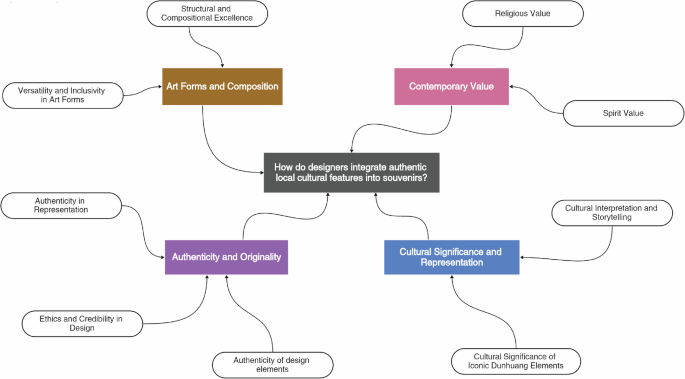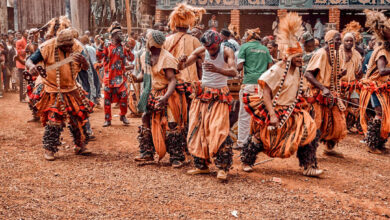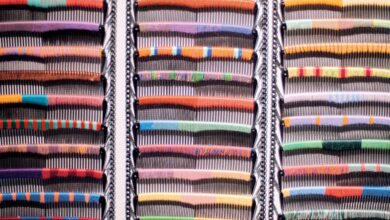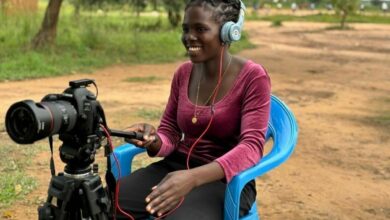Authenticity in souvenir design integrating cultural features of Dunhuang’s mural heritage: a qualitative inquiry

The study aims to identify the local cultural features of designing authentic souvenirs and the possible influences. When asked about the cultural features of Dunhuang, the designers generally recount their understanding of the external and internal features of Dunhuang. In contrast, cultural experts focus more on its internal identity. Participants define Dunhuang murals’ key aesthetic and artistic features, emphasizing their contemporary relevance and origins in cultural exchange. They also stress the importance of authenticity and originality in cultural product design, particularly in commercial contexts. Overall, participants affirm the cultural significance and representational role of Dunhuang heritage. Figure 1 shows the critical themes in incorporating elements of the Dunhuang Mogao murals into the design of souvenirs.
Art forms and composition
Dunhuang’s cultural and artistic heritage is rich and layered, comprising a variety of art forms and their unique interpretations. D-YQ presents that “the art of the Dunhuang caves can be broadly categorized into three parts: murals, sculptures, and architecture, each of them has a unique design aspect.” This notion is echoed by D-JJ, who suggests that “ the Dunhuang mural serves as a culmination of a master’s work or comprehensive exemplar.” Dunhuang’s artistic creations represent a historical narrative of Chinese painting; the cave art chronicles the transition from early rock art to techniques of advanced Chinese ink painting, preserving artistic methods and styles that capture the various historical epochs, such as the “depictions of blue-green landscapes from the Tang Dynasty.” Complementing this perspective, E-JYZ offers views on the expansive and enduring nature of Dunhuang’s art and culture, which is about its ethnic, local, and global aspects.
“An international brand and an inexhaustible resource for artists. Regardless of their discipline, anyone involved in art can draw inspiration from Dunhuang. Whether painting, sculpture, architecture, music, or dance, there is always something valuable to gain if you come to learn in Dunhuang.” (E-JYZ)
Dunhuang’s cultural and artistic heritage is multifaceted, with unique design elements. Its value as an international brand and a limitless source of inspiration for artists across disciplines, from painting to music and dance.
Contemporary value
Religious value
Several designers share the connection between Buddhism and the culture of Dunhuang’s caves. D-JJ observes that “the foundational elements of the art and culture in the Dunhuang caves are heavily influenced by Buddhism, with its sculptures, murals, and architectural designs all drawing from Buddhist themes.” D-XB suggests that “Mogao’s art and culture are the most reflective of the ancient Silk Road’s thousand-year culture and have immeasurable preservation value for future generations.” D-YQ and D-HP discuss how the art reflects personal experiences and religious rituals, with D-HP mentioning that “the murals are based on people’s lives and religious activities, and every year, we would go to the Mogao Caves on the Bathing Buddha Festival, partaking in activities like rejoicing with Buddha.” D-HP and E-ZYZ contribute a layered perspective, pointing out,
“The art of Mogao is more like a by-product of spreading Buddhism. As time progressed, there was a transformative shift in their significance: the caves transcended their initial religious purpose, and their artistry became more dominant and widely recognized. Moreover, what brings out the splendor of the Mogao Caves is not just Buddhism but faith, which is an expression of internalization.” (D-HP, E-ZYZ)
Once internalized and later expressed externally, the faith transforms into an artistic expression. While Mogao’s art and culture originate from Buddhist traditions, their impact extends beyond spiritual confines. The creative works act as vessels for Buddhist teachings and reflect the history, societal customs, and the potency of faith that is part of the Silk Road’s legacy. Therefore, the Mogao heritage is a cultural and spiritual treasure within the history and spiritual narrative.
Spirit value
Furthermore, the art of the Mogao Caves offers a deep reflection of the human psyche. “The mind state of the people is instrumental in shaping the artistic landscape of this region” (D-PC). The mental aspect resonates with a broader cultural ethos, “a reverence for nature as a cornerstone of Chinese philosophy” (E-ZYZ). E-ZYZ appreciates the quality of Mogao art that thrives in extreme environments, for “it represents an innate human love for life, and the essence of love is to stimulate creativity.” This idea is vividly captured in the phrase “the romance of stones blossoming, which reflects the transformative power of art in a desert landscape characterized primarily by its monotone color palette.” He further figures out that the art of Mogao fundamentally focuses on the pursuit of beauty: “This beauty serves to record history, reflect reality, and express a longing for a good life.”
The creations within Mogao are not solely depictions of historical or religious ideologies but also represent a broader spectrum of human values. E-JYZ reflects on a childhood time in Dunhuang:
“In Dunhuang, since childhood, I have been walking this path, interacting primarily with those involved in history and art—people in these cultural circles. The interconnectedness of Dunhuang’s history, art, and community creates a unique environment that attracts and inspires many as a hub for cultural exchange and artistic innovation.” (E-JYZ)
Ultimately, the artworks of the Mogao Caves are not just historical chronicles or manifestations of aesthetic concepts but a “mirror reflecting the human condition,” in the words of E-ZYZ. Dunhuang art witnesses the indomitable human spirit, from fostering creativity to overcoming harsh environmental conditions, from filtering negativity to manifesting the beauty of life. The unique blend of psychological, cultural, and ecological factors gives Dunhuang art enduring appeal.
Authenticity and originality
Authenticity in representation
Authenticity is essential in portraying traditional art forms such as the murals of Dunhuang. D-HP suggests adhering to original methods and materials to ensure replicas are as authentic as possible.
“Mud Board Paintings are locally sourced in Dunhuang, the soil from the local Dangquan River, to restore the previous craftsmanship or material. The reproduction process for Mud Board Paintings follows the original creation methods, from making the mud board to drying and painting, reflecting the accumulation of many dynasties.” (D-HP)
Such practices achieve “a sense of restoring the old with the old.” The key is to set boundaries and maintain the integrity of the original elements instead of reinterpreting or modifying them in pursuit of a creative vision. D-HP suggests that some of the “masterpieces painted by our ancestors can be kept intact or carried in a more popular or better product form… and there’s no need to redraw or reimagine them.” The reason is that the works made by the ancestors have an intrinsic value that modern adaptations cannot surpass. He said, “We won’t change these things, even if it means incurring a loss, still insisting on presenting the authentic feel of the Dunhuang murals in the products.” This view suggests that innovation is a cautious approach to respecting tradition and avoiding unnecessary alterations. D-FF pays particular attention to “restoring the mural’s original color and enhancing it.”
However, what worried D-HP was the rise of online products that claimed to be inspired by Dunhuang but lacked recognizable or authentic elements from the Mogao Caves. He asserts that while creativity and adaptability are essential, some aspects or “roots” are non-negotiable and should “remain intact.” Therefore, balancing the complexities of tradition and innovation becomes particularly important in adapting traditional Dunhuang elements into modern products. E-ZYZ also outlined the importance of balancing “local authenticity and overall authenticity” in product design.
Authenticity of design elements
Some designers are dedicated to authentically preserving the historical appearance and intrinsic style of the Dunhuang Mogao Murals when they design souvenirs. D-FF insists on fidelity to the initial creation, remarking, “Firstly, it will still be based on the original image and color.” She references features such as “the wings of the winged horse” can be “customized according to the image of the mural.” Further detailing her approach, she says, “I don’t want to rebuild a Mogao Mural; instead, I want to present it more completely to everyone.” D-XB draws attention to the time-weathered nature of the murals, describing that “the mural has a mottled feel because it has gone through more than 2,000 years of oxidation.” By mentioning a mural adorned with diminutive Buddha faces that have darkened over centuries, she dedicates balance to honoring the original hues while infusing modern elements that resonate with contemporary viewers. Similarly, D-JJ also presents the necessity of “ensuring the original color of the mural” and is prudent to avoid “major changes” to the coloration, considering both its style and “painting by use mineral pigments.”
Essentially, these designers are committed to preserving the murals’ original character and the venerable patina they have acquired over time. Their overarching design philosophy is anchored in the principle of honoring and safeguarding the core attributes like form and hue that define the cultural heritage with which they engage.
Ethics and credibility in design
D-PC and D-HP affirm the close relationship between “authority” and “authenticity” in cultural heritage and design. D-PC emphasizes the importance of authoritative institutions, such as the Dunhuang Academy and Dunhuang Cultural Tourism Group, which lend legitimacy to their work. D-HP notes that the market responds favorably to expert artisans’ authentic works and craftsmanship, like the Dunhuang Academy’s seasoned painters. Despite higher costs, discerning clients value genuine artistry and are willing to invest in it. He advises artists to remain true to their vision, encouraging them to “follow your path” and appeal to those who genuinely appreciate their efforts rather than catering to the masses. According to him, achieving commercial success and artistic integrity depends on concerning the niche audience while maintaining authenticity. When a recognized authority endorses this view, it becomes a defining feature in the cultural heritage marketplace.
Nevertheless, a particular conflict exists between maintaining authenticity in design and personal bias when developing products influenced by cultural heritage. D-HP observes that designers with prestigious academic backgrounds may inject “a strong sense of individualism into their work, sometimes overloading it with too many ideas.” This over-personalization can diminish the authenticity and core identity of the cultural elements represented. Thus, despite their visual appeal, these products need a deeper, more authentic connection to the culture they depict.
“Adhering to the classics or the source is crucial, especially with the cultural elements. But sometimes, if the designer is too individualistic, they may ‘draw legs on a snake.’ These Dunhuang Ips look beautiful but have nothing to do with Dunhuang.” (D-HP)
Balancing authority and authenticity in cultural heritage design is essential for artistic integrity and commercial success.
Cultural significance and representation
Cultural significance of iconic Dunhuang elements
D-PC regards the historical and cultural relevance of the motifs used in design. He notes, “If we trace its origins, it has wide applications in early Europe and Central Asia, for instance, the pattern of Three Rabbits and Four Rabbits Share Ears. This choice is far from arbitrary.” Such choices are deliberate and informed by “its historical background, as well as the pattern’s development, transformation, and evolution.” The thorough understanding and precise representation of cultural narratives significantly inform their design choices. “If the amount of knowledge or the clarity of the cultural narrative is sufficiently clear and can present a particularly grand cultural state, we are more willing to undertake such work.” This method proves their comprehensive research and dedication to historical and cultural authenticity. D-XB affirms the lasting significance and charm of Dunhuang’s iconic motifs.
“Like the Feitian (flying Apsara) and the Jiuselu (Nine-Colored Deer) have been well-known, continuously circulated classic elements; these are certain ‘hot’ cultural IPs, lots of souvenirs based on the elements, so this IP has been popular from the beginning to now in this culture category” (D-XB).
When designers follow historical authenticity and deeply understand the cultural meaning in the design process, they foster an ongoing dialogue about the role of cultural heritage in modern design.
Cultural interpretation and storytelling
Drawing on cultural heritage, designers such as D-DM, D-XB, and D-JJ consider not only the visual appeal of products but also incorporate the functional and cultural significance of the murals into their work. D-XB explains the dual role of the “ ZaojingFootnote 1“ architectural element, which is decorative and implies fireproofing.
“The symbolism of Zaojing is quite apparent; it was originally a metaphor for fire prevention in (Chinese) ancient architectural decoration…So, when we utilize the Zaojing in our designs, we use some design techniques that strongly connect to water and fire.” (D-XB)
Similarly, D-JJ delivers a holistic approach that combines cultural expression with modern product design. She mentions a tearable note tab designed in the image of the Mogao Grottoes cliffs at Dunhuang, infused with the thematic idea of “Lighting Up Mogao, which is about conveying a topic of guardianship.” This concept presents the ideological dimension of product design, which essentially means to evoke the consumer’s memories of a specific cultural or historical context for achieving a visually appealing product with desirable value. In discussing the distinctive approach to product design and display, D-JJ refers to ‘product stories’ that distinguish their items from other museums.
“ What sets us apart from other museums is our product’s story. It concentrates on the product’s cultural essence, connection with Dunhuang, and practical usefulness. The explanation combines the content with the product itself. This storytelling could extend to the product details page.” (D-JJ)
These approaches rely on designers’ comprehensive understanding of connecting cultural heritage and commercial products, which can bridge the gap between culture and consumer goods.
Source link




